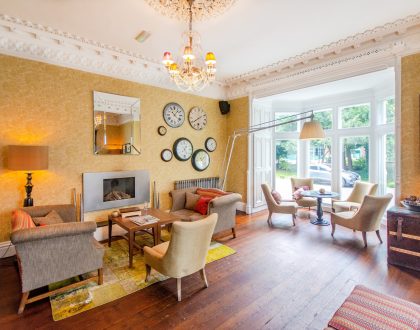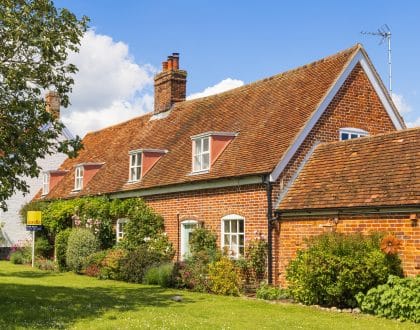Top 5 DIY soundproofing tips for a quieter home

In today’s fast-paced world, the quest for a serene and noise-free environment has become a priority for many homeowners. Whether it’s the bustling city sounds, noisy neighbours, or the desire for a peaceful work-from-home space, soundproofing your home can significantly enhance your living experience. As heat pumps become an increasingly popular method for cutting down energy bills, quieter home solutions will be needed. While professional soundproofing solutions exist, DIY options offer cost-effective and satisfying ways to achieve a quieter home. Join us as we dive deep into decibel defying solutions; here are our top five DIY soundproofing methods.
5. Use of Acoustic Panels
Acoustic panels are designed to absorb sound waves, reducing the echo and reverberation within a room. These panels are typically made from foam or fibrous materials and can be easily mounted on walls or ceilings. For a DIY approach, homeowners can create their own panels by using sound-absorbing materials like rockwool or fibreglass insulation, encased in fabric for an aesthetically pleasing finish. While effective in controlling sound reflections, acoustic panels are more suited for improving the sound quality inside a room rather than blocking external noise.
4. Draft Stoppers and Door Seals
Gaps and cracks around doors and windows are common culprits for sound leakage. Draft stoppers and door seals offer a simple yet effective DIY solution to this problem. By sealing these gaps, you can prevent outside noise from entering the room. Weatherstripping and door sweeps are affordable and easy to install, making them an accessible option for most homeowners. While these measures are effective at combating light to moderate noise, they might not be sufficient for louder environments.
3. Mass-Loaded Vinyl (MLV)
Mass-Loaded Vinyl is a dense, flexible material used to block sound transmissions. It can be applied to walls, ceilings, and floors or used to wrap noisy pipes. The installation of MLV is straightforward: it can be cut to size and attached to surfaces with adhesive, screws, or nails. Its high mass helps to block airborne noise, making it an effective soundproofing material. However, the cost of MLV can be a drawback for larger projects, and its heavy nature might require additional support when used on walls or ceilings.
2. Carpeting and Rugs
One of the simplest DIY soundproofing strategies involves the use of thick carpets and rugs, especially in rooms with hard flooring surfaces. These materials can absorb sound, reducing the impact of footsteps and other impact noises. For enhanced soundproofing, consider using a dense rug pad underneath your carpets or rugs. While this method is effective for dampening impact noise, it has limited effectiveness against airborne noise such as conversations or music.
1. Secondary Glazing
Secondary glazing stands out as the premier choice for DIY soundproofing for several reasons. Unlike other methods that primarily address internal noise or minor external disturbances, secondary glazing offers a comprehensive solution to significantly reduce noise from outside. This technique involves adding an extra layer of glass to existing windows, creating an air gap that acts as a sound barrier. There’s so many great benefits of secondary glazing:
- Superior Noise Reduction: The air gap between the primary window and the secondary glaze significantly reduces the transmission of sound, offering quieter spaces even in noisy urban environments.
- Energy Efficiency: Secondary glazing enhances thermal insulation, keeping your home warmer in winter and cooler in summer and saving energy.
- Cost-Effective: Compared to replacing windows with double or triple glazing, secondary glazing is a more affordable option that delivers comparable soundproofing benefits.
- Preservation of Aesthetics: For historic homes or buildings where changing the external appearance is not desirable or allowed, secondary glazing offers an effective internal solution that preserves the building’s character.
- Ease of Installation: With basic DIY skills, homeowners can install secondary glazing kits, making it a practical and satisfying project.
Installation Tips for Secondary Glazing
When considering secondary glazing, it’s important to ensure a tight seal around the edges to maximise soundproofing capabilities. Measuring accurately and choosing high-quality glazing materials can make a significant difference in performance. Additionally, the thickness of the glass used in secondary glazing can affect its soundproofing effectiveness, with thicker materials generally providing better results.
Creating a quieter home environment doesn’t have to be an expensive or overwhelming project. With the right materials and a bit of elbow grease, you can significantly reduce unwanted noise. Each of the DIY soundproofing methods mentioned offers its own set of benefits, catering to different needs and budgets. When it comes to achieving the best balance between cost, ease of installation, and effectiveness, secondary glazing emerges as the standout choice. Not only does it excel in reducing external noise, but it also enhances the thermal efficiency of your home, making it a smart investment. Get in touch with our team today and see how we can benefit you.
Recommended Posts

Tired Of Unwanted Noise? Here’s How Clearview Secondary Glazing Customers Have Benefitted!
24/06/2025

Magnetic Secondary Glazing Or DIY Kits?
12/06/2025

Creating A Quiet Haven At Home
05/06/2025

 10 Year Guarantee
10 Year Guarantee 5 Star Customer Reviews
5 Star Customer Reviews